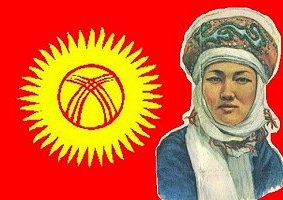KYRGYZSTAN
Capital: Bishkek
Area: 198,500 km˛
Population: 4,685,230 (July 2000 est.)
Language(s): Kirghiz (Kyrgyz) - official, Russian - official
Ethnic Groups: Kirghiz 52.4%, Russian 18%, Uzbek 12.9%, Ukrainian 2.5%, German 2.4%, other 8.3%
Religion(s): Muslim 75%, Russian Orthodox 20%, other 5%
Currency: 1 Kyrgyzstani som (KGS) = 100 tyiyn
System of Government: Republic
     
The Kyrgyz are of Mongolian, East-Turkic and Kypchak origin. The oldest reliable source mentioning the Kyrgyz is from the 8th c. In the 9th c., a great Kyrgyz state was the most powerful in Central Asia.
After the Mongol Golden Horde conquest in 1218, a group of Kyrgyz migrated southward, leaving their original territory in the Upper Yenisey river basin, arriving to the Western Tien Shan region, familiar as the modern Kyrgyz homelands. During the period of struggle against the Mongols, the Kyrgyz began to convert to Sunni Islam.
In the 17th c., the Yenisey Kyrgyz came under Kazakh political control. The Tien Shan Kyrgyz lived in relative peace until the 1680s, when they were forced to flee into neighboring Turkestan from a terrible onslaught by the Kalmyks (Mongolian Buddhists). The Kyrgyz were reunited in 1758 as the deported Tien Shan Kyrgyz were allowed to return, after the Kalmyk/Oirot Federation was defeated by the Manchus. China also sought to subjugate the Kyrgyz, but they were able to remain virtually independent.
Contacts with the Russians began in the mid-17th c., and after 1758 Russia started meddling in Kyrgyz internal affairs. By 1867, the Russians took over most of Turkestan. The Kyrgyz were forced to accept Russian rule by 1876, after fighting them in a Muslim Holy War. The Russians encouraged Slavic, Cossack and German immigration into Kyrgyzistan, and these colonists competed for the most productive agricultural land, which was assigned by the Cossack army of Semireche. The pasturage of the native Kyrgyz was severely restricted, and they were forced into a vicious cycle of herd reductions and ever-declining living standards. Northern Kyrgyzistan became one of the most neglected and under-developed areas of Russian Central Asia. In 1898, Kyrgyz united with Uzbek and Tajik farmers in an uprising against the Russian regime, but this was crushed by military intervention.
In 1916, as the Russian Army in the First World War was desperate for more troops, the Russians for the first time introduced general military conscription among the peoples of Central Asia. This spurred a general revolt, in which the Kyrgyz also took part. As the Russian Revolution and the subsequent Civil War started in 1917, the Kyrgyz were still suffering from the consequences of the 1916 Revolt. In the Civil War, the Kyrgyz sided with the White forces against the Bolshevik Red Army, and were defeated in 1919. The Bolsheviks then divided the Kyrgyz land among the various provinces of the newly created Turkestan ASSR. In the beginning, the Bolsheviks continued tsarist policies of encouraging colonization, but as the Basmachi Revolt exploded in Turkestan, a land reform was instituted in Kyrgyzistan in 1921, returning colonized land. In 1924, Kyrgyzistan was given the status of Autonomous Oblast within the RSFSR. In 1926, it was upgraded to Kyrgyz ASSR, and in 1936 to Kyrgyz SSR, a full constituent republic of the Soviet Union.
Kyrgyz resistance against collectivization around 1930 was fierce. Many slaughtered their livestock and fled to China, rather than submit. The Basmachi rebels reappeared. The Communist regime feared futher revolt, and Kyrgyz political and intellectual leaders were purged both in 1927-29 and 1935-39.
A presidential parliamentary democracy was established in an independent Kyrgyzstan in 1991.
Source: Norwegian Institute of International Affairs [NUPI] - Centre for Russian Studies
Photos: Daniel C. Waugh, Viktor Polynsky, Daniyar Kazakov, Mambet Kalpaev, State Directorate Manas-1000, Kyrgyz Silk Road National Foundation
    
© Copyright HUNMAGYAR.ORG
|


















